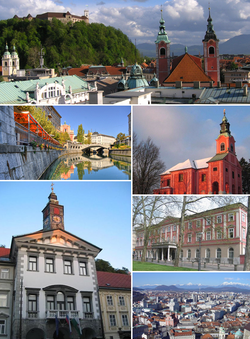Ljubljana
Ljubljana is the capital city of Slovenia. It is the largest city in that country. The city became the most important settlement in the area when Romans ruled Slovenia. There are many museums with things from that time in Ljubljana.
City | |
 | |
| Coordinates: 46°03′20″N 14°30′30″E / 46.05556°N 14.50833°ECoordinates: 46°03′20″N 14°30′30″E / 46.05556°N 14.50833°E | |
| Country | Slovenia |
| Municipality | City Municipality of Ljubljana |
| First mention | 1112–1125 |
| Town privileges | 1220–1243 |
| Government | |
| • mayor | Zoran Janković (PS) |
| Area | |
| • Total | 163.8 km2 (63.2 sq mi) |
| Elevation | 295 m (968 ft) |
| Population (2014)[2] | |
| • Total | |
| • Density | 1,695/km2 (4,390/sq mi) |
| Time zone | UTC+1 (CET) |
| • Summer (DST) | UTC+2 (CEST) |
| Postal codes | 1000—1211, 1231, 1260, 1261[3] |
| Vehicle Registration | LJ |
| Website | www.ljubljana.si |
As of 2002, there were 265,881 people living in Ljubljana. The University of Ljubljana is in Ljubljana.
Geography
The city has an area of 163.8 square kilometers (63.2 sq mi). It is located about 320 kilometers (200 mi) south of Munich, 477 kilometers (296 mi) east of Zürich, 250 kilometers (160 mi) east of Venice, 350 kilometers (220 mi) southwest of Vienna, 224 kilometers (139 mi) south of Salzburg and 400 kilometers (250 mi) southwest of Budapest.
Ljubljana is 295 meters (968 ft) above sea level.
The main bodies of water in Ljubljana are the Ljubljanica, the Sava, the Gradaščica, the Mali Graben, the Iška and the Iščica Rivers.
July and August are the warmest months. The daily temperatures at these times are generally between 25 and 30 °C (77 and 86 °F). January is the coldest month with temperatures closer to 0 °C (32 °F). Ljubljana is also one of the wettest European capitals. Yearly precipitation is about 1,400 mm (55 in). It can also snow anytime from December to February.
Cityscape
Ljubljana features many kinds of architectural styles. Prominent buildings include Prešeren Square, Ljubljana Castle, Town Hall, Ljubljana Cathedral, and Nebotičnik.
There are also several parks around the city. Tivoli City Park (Mestni park Tivoli) is the largest park in Ljubljana.
The most notable bridges of Ljubljana are the Triple Bridge (Tromostovje), the Trnovo Bridge (Trnovski most), the Dragon Bridge (Zmajski most), the Hradecky Bridge (Slovene: Hradeckega most), and the Butchers' Bridge (Mesarski most). The Trnovo Bridge crosses the Gradaščica, whereas the others cross the Ljubljanica.
Twin cities
Ljubljana Media
Depiction of the city's coat of arms featuring the dragon on top of the castle, from Valvasor's The Glory of the Duchy of Carniola, 1689
Excavations at the building site of the planned new National and University Library of Slovenia. One of the discoveries was an ancient Roman public bath house.
"Laybach" (Ljubljana) in Johann Weikhard von Valvasor's work The Glory of the Duchy of Carniola of 1689
Celebration during the Congress of Laibach, 1821
The oldest preserved film recordings of Ljubljana (1909), with a depiction of streets, the Ljubljana tram, and a celebration. Salvatore Spina Company, Trieste.
Overview of Mount Saint Mary, the highest hill in Ljubljana, with the peak Grmada reaching 676 m (2,218 ft)
References
- ↑ "Nadmorska višina naselij, kjer so sedeži občin" [Height above sea level of seats of municipalities] (in Slovenian and English). Statistical Office of the Republic of Slovenia. 2002. Archived from the original on 2013-05-24. Retrieved 2016-02-20.
{{cite web}}: CS1 maint: unrecognized language (link) - ↑ "Ljubljana, Ljubljana". Place Names. Statistical Office of the Republic of Slovenia. Archived from the original on 4 March 2016. Retrieved 25 June 2015.
- ↑ Zip Codes in Slovenia from 1000 to 1434 (in Slovene) Acquired on 28 April 2015.
Other websites
- The official Ljubljana page, in Slovene and English
- History and Travel Information Archived 2007-09-30 at the Wayback Machine









